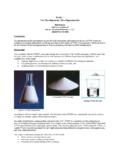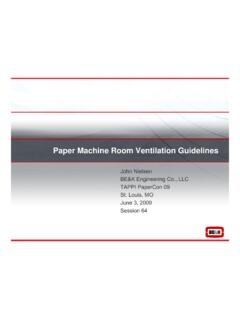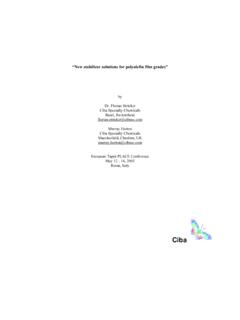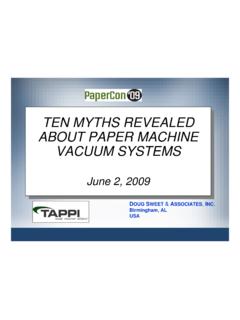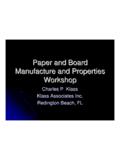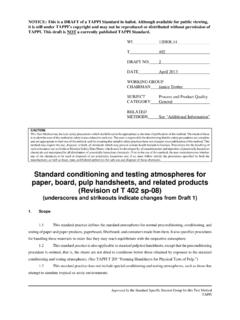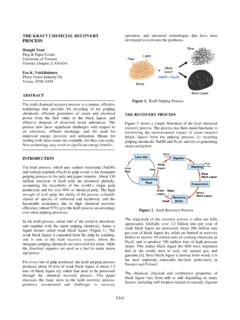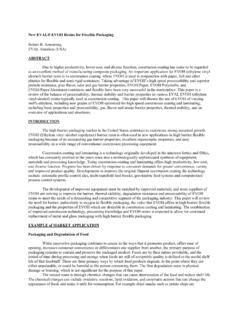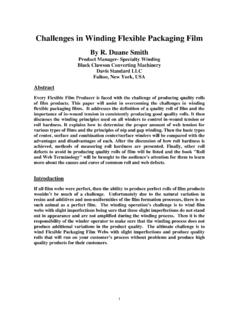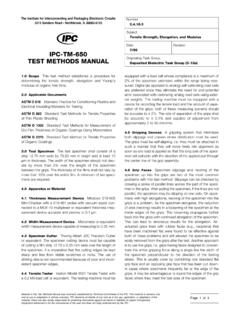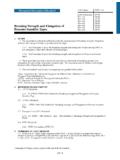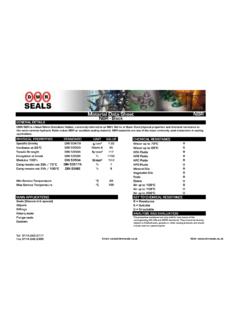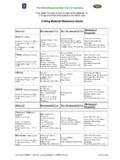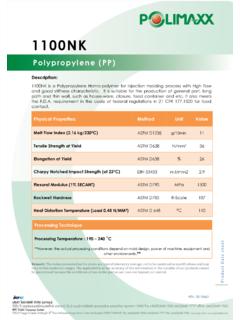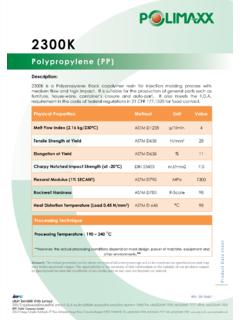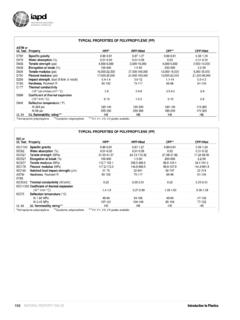Transcription of Tensile properties of paper and paperboard (using …
1 WI T 494 DRAFT NO. 2 DATE June 13, 2006 TAPPI WORKING GROUP CHAIRMAN D Muchorski SUBJECT CATEGORY Physical properties RELATED METHODS See Additional Information Approved by the Standard Specific Interest Group for this Test Method TAPPI CAUTION: This Test Method may include safety precautions which are believed to be appropriate at the time of publication of the method.
2 The intent of these is to alert the user of the method to safety issues related to such use. The user is responsible for determining that the safety precautions are complete and are appropriate to their use of the method, and for ensuring that suitable safety practices have not changed since publication of the method. This method may require the use, disposal, or both, of chemicals which may present serious health hazards to humans. Procedures for the handling of such substances are set forth on Material Safety Data Sheets which must be developed by all manufacturers and importers of potentially hazardous chemicals and maintained by all distributors of potentially hazardous chemicals. Prior to the use of this method, the user must determine whether any of the chemicals to be used or disposed of are potentially hazardous and, if so, must follow strictly the procedures specified by both the manufacturer, as well as local, state, and federal authorities for safe use and disposal of these chemicals.
3 Tensile properties of paper and paperboard (using constant rate of elongation apparatus) (Revision of T 494 om-01) (Underlines indicated changes/corrections since last draft) 1. Scope This test method describes the procedure, using constant-rate-of- elongation equipment, for determining four Tensile breaking properties of paper and paperboard : Tensile strength, stretch, Tensile energy absorption, and Tensile stiffness. This procedure is applicable to all types of paper and paperboard within the limitations of the instruments used, whether the instruments perform horizontal or vertical tests or whether they are manually operated or computer controlled. It is also applicable to handsheets, with modifications, as specified in TAPPI T 220 Physical Testing of Pulp Handsheets. It does not apply to combined corrugated board.
4 T 494 om-01 Tensile properties of paper and paperboard / 2 (using constant rate of elongation apparatus) 2. Definitions Tensile strength, the maximum Tensile force developed in a test specimen before rupture on a Tensile test carried to rupture under prescribed conditions. Tensile strength (as used here) is the force per unit width of test specimen. Stretch, the maximum Tensile strain developed in the test specimen before rupture in a Tensile test carried to rupture under prescribed conditions. The stretch (or percentage elongation ) is expressed as a percentage, , one hundred times the ratio of the increase in length of the test specimen to the original test span. Tensile energy absorption (TEA), the work done when a specimen is stressed to rupture in tension under prescribed conditions as measured by the integral of the Tensile strength over the range of Tensile strain from zero to maximum strain.
5 The TEA is expressed as energy per unit area (test span width) of test specimen. Tensile stiffness, the ratio of Tensile force per unit width to Tensile strain within the elastic region of the Tensile -strain relationship. The elastic region of the Tensile -strain relationship is the linear portion of the load- elongation relationship up to the elastic limit. The elastic limit is the maximum Tensile force above which the load- elongation relationship departs from linearity. ( Tensile stiffness is numerically equivalent to E t, where E is the modulus of elasticity and t is sample thickness.) Breaking length, the calculated limiting length of a strip of uniform width, beyond which, if such a strip were suspended by one end, it would break of its own weight. Tensile index, the Tensile strength in N/m divided by grammage.
6 NOTE 1: ISO/TC6 recommends the use of Tensile index over breaking length. See TAPPI T 1210 or TIP 0800-01 Units of Measurement and Conversion Factors. 3. Significance Tensile strength is indicative of the strength derived from factors such as fiber strength, fiber length, and bonding. It may be used to deduce information about these factors, especially when used as a Tensile strength index. For quality control purposes, Tensile strength has been used as an indication of the serviceability of many papers which are subjected to a simple and direct Tensile stress. Tensile strength can also be used as an indication of the potential resistance to web breaking of papers such as printing papers during printing on a web fed press or other web fed converting operations.
7 When evaluating the Tensile strength, the stretch and the Tensile energy absorption for these parameters can be of equal or greater importance in predicting the performance of paper , especially when that paper is subjected to an uneven stress such as gummed tape, or a dynamic stress such as when a sack full of granular material is dropped. Stretch (sometimes evaluated in conjunction with bending resistance) is indicative of the ability of paper to conform to a desired contour, or to survive nonuniform Tensile stress. It should be considered important in all papers, 3 / Tensile properties of paper and paperboard T 494 om-01 (using constant rate of elongation apparatus) but is of particular importance in papers where stress-strain properties are being modified or controlled. This includes creped paper , pleated paper , air-dried paper , and paper that has been made extensible through mechanical compaction.
8 Stretch may be used as an indication of the amount of crepe in tissues, towels, napkins, and similar grades. Stretch is evaluated in decorative papers and certain industrial grades such as paper tapes and packaging papers, both as an index of how well the paper will conform to irregular shapes and, along with Tensile energy absorption, as an indication of the paper s performance under conditions of either dynamic or repetitive straining and stressing. Stretch has also been found important in reducing the frequency of breaks on high-speed web fed printing presses such as are used to print newspapers. Tensile energy absorption is a measure of the ability of a paper to absorb energy (at the strain rate of the test instrument), and indicates the durability of paper when subjected to either a repetitive or dynamic stressing or straining.
9 Tensile energy absorption expresses the toughness of the sheet. An example of this is a multi-wall sack that is subject to frequent dropping. In packaging applications such as multi-wall sacks, favorable drop tests and low failure rates have been found to correlate better with Tensile energy absorption than with Tensile strength. Tensile stiffness tells of the stiffness of the sheet and often gives a better indication of the mechanical response of the sheet to converting forces than does failure criteria. 4. Apparatus Tensile testing machine1, a constant-rate-of- elongation type (1), meeting the following requirements: Two clamping jaws, each with a line contact for gripping the specimen, with the line contact perpendicular to the direction of the applied load and with means for controlling and adjusting the clamping pressure.
10 NOTE 2: Line contact describes the clamping zone resulting from gripping the specimen between a cylindrical and a flat surface or between two cylindrical surfaces whose axes are parallel (2). NOTE 3: For certain grades of paper line contact jaws may not be appropriate and it may be necessary to substitute flat gripping surfaces. Certain grades are damaged by the line contact loading between cylindrical and flat surfaces. The use of emery cloth on flat gripping surfaces will help minimize slippage for some board grades. The clamping surfaces of the two jaws shall be in the same plane and so aligned that they hold the test specimen in that plane throughout the test. The clamping lines shall be parallel to each other within an angle of 1 , and shall not change more than during the test. The applied Tensile force shall be perpendicular to the clamp lines within 1 throughout the test.
